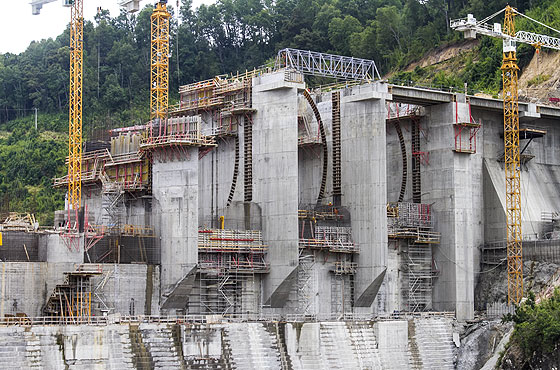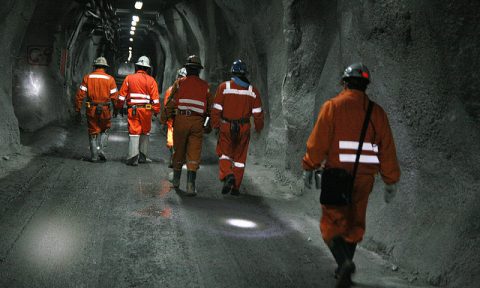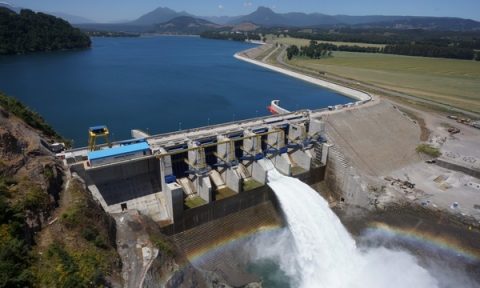Angostura: Colbún begins the first large hydropower in 10 years

Developed by Colbún, it will have a capacity of 316 MW. It will be the third such plant located in the Bío Bío Region and the last to come on stream in the next five years.
In September 2004, the Ralco Hydroelectric plant (690 MW)-developed by Endesa-was opened near Los Angeles, in the Bío Bío Region.
Its construction, as well as with the Pangue Plant, in 1996, went through a series of conflicts with surrounding communities, mainly pehuenches, represented by the sisters Berta and Nicolasa Quintremán. The projects involved the relocation of families living in the area, as the territories would be under water.
Today, 10 years after the start up of Ralco, Colbún-controlled by Matte Group-will give the OK to Angostura, the third Plant of its kind in the Bio Bio Region, and the one to come into operation in the country in the next five years, after the suspension of HidroAysén.
President Michelle Bachelet and Energy Minister, Máximo Pacheco, who have emphasized the development of the Energy Agenda, will be present at the opening of Angostura. At the Ralco’s OK did not attended former President Ricardo Lagos.
The Angostura Plant has a capacity of 316 MW and will be located in the municipalities of Santa Barbara and Quilaco, it use the water resources of the Biobío and Huequecura rivers, with an investment of about $ 700 million and sees an average annual generation of 1,542 GW/h.
In the 60s, Endesa developed studies on the hydroelectric potential in the Biobío river basin. The analysis concluded that there could be built up to six plants of this type.
According to company estimates, Angostura will supply about 3% of the energy demand of the Central Interconnected System (SIC). Thus, its potential installed equals demand from communes as Ñuñoa, and about 70% of the demand of Concepción.
Its construction, with the flooding of 641 hectares, meant the transfer of 126 people or 46 families, among which most were under the poverty line. Some of them even had faced a process of relocation when Pangue was built.- According to information from the National Energy Commission (CNE), currently there are 12 river hydro projects under construction, which together will have a capacity of 1014.4 MW. Among these, half have as entry date this year; two in 2015; two in 2017 and one in 2018 and 2019.
Amid the energy challenges facing the country, where the lack of implementation of generation projects, the high cost of energy and the possible entry of new players to the system are recurrent topics among business and political actors, experts say the Angostura input is positive, and even qualify it as milestone, considering the prosecution of major initiatives in recent times and, above all, by the recent suspension of the project developed by Endesa and Colbún, HidroAysén (2,750 MW).
The former Executive Secretary of the National Energy Commission (CNE) and current general manager of Energy, María Isabel González, says it is important the use of hydropower in Chile, as it is the only conventional energy source with which the country.
“Having retaken the development of hydroelectric projects (…) is a good sign that things can be done in compliance with environmental standards,” she said.
In that vein, she noted that the contribution that Angostura will do to the system will depend on the amount of rainfall during the year. While these are higher, the lower the marginal costs (which are paid by enterprises to buy power on the spot market).
Ramon Galaz, Valgesta’s CEO, agrees and adds that benefit most from the effects of the plant will be the customers whose contracts are subject to the variation of the marginal cost. “In the case of Mrs. Juanita (regulated customers), one could expect is that the effects of the entry of these plants are reflected in future tenders”, he added.
However, he warned that given the problems existing in the transmission system, “in certain scenarios around the hydro contribution of the new plant would be no advantage in its sweet spot.” That, of certain transmission constraints or congestion levels of the system, that do not allow the energy to flow as expected for a few lapses.
When analyzing the startup of Angostura, Hugh Rud-nik, Academician of the Catholic University makes an important scope: “That it has developed a hydro project is a first good news. The second is that you were able to develop in the basin of Biobío, which was a problem in the past with projects such as Ralco and Pangue “.
This is reflected in the few and almost zero problems experienced by Angostura for its realization. While the initiative received environmental approval in 2009, after its Environmental Impact Study received over 200 comments from the public-services, work with neighboring communities were initiated while the environmental processing. Thus, the company identified a number of mitigations, supported by the firm Tecnoservice, among which is the Angostura Park, empowerment initiative considered two public beaches, a botanical garden, a campground, a circuit of trails and a gazebo to Huequecura river.
María Isabel González recalls that when Ralco was processed, the State promoted and funded much of the costs of displacement of families. Today, however, she adds that the role of state and government is more limited and is intended to define policies for energy development at the national level and not a particular project.
Source: La Tercera











